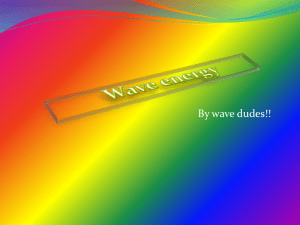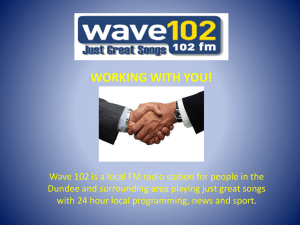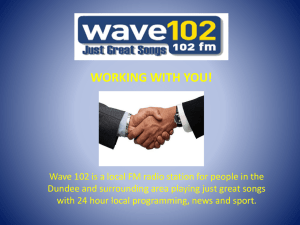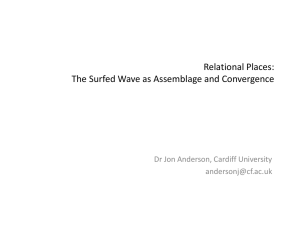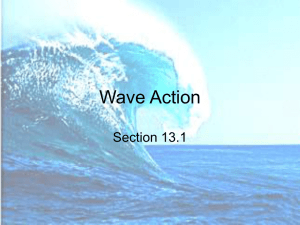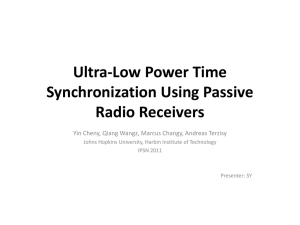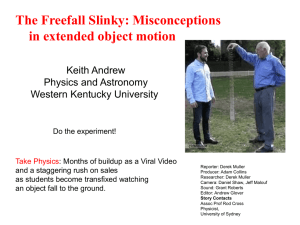File - Science Leadership Network
advertisement
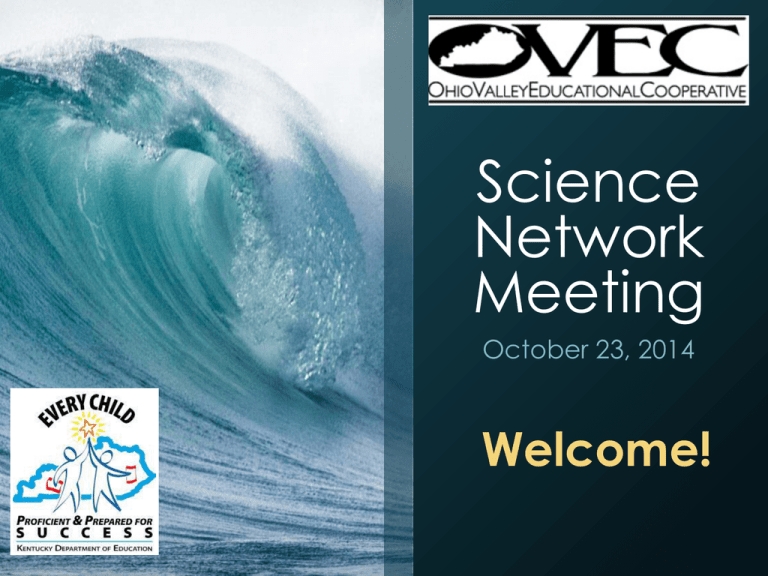
Science Network Meeting October 23, 2014 Welcome! Agenda • Introduction Instruction • Wave & Shifts in Experience • Assessment • Lesson Literacy Idea Development • Reflection & Wrap-Up The Four Pillars of the Networks • Standards • Educational Leadership • Assessment Literacy • Characteristics of Highly Effective Teaching and Learning Making the Shift http://vimeo.com/53913251 Consider Last Month’s Lesson… Predicting Motion Student Science Performance A. Gathering: Students in groups of two compare the motion of 2 pendulums of different lengths (provided), and work collaboratively to quantify this comparison. Students develop and use a table to record data. Hint: Be sure to have lengths of significant difference (i.e., 20 cm and 60 cm). Hint: Engage students in generating ideas for quantification of measurements] How can we do better than “fast” and “slow”? Contrast with this experience… Pendulum Lab Name ____________________ 1. Get 1 pendulum that measures 20 cm and 1 pendulum the measures 60 cm from the supply table. 2. Count how many times each pendulum swings back and forth in 10 seconds and record your measurements in the table below. Repeat twice. 20 cm pendulum Trial 1 Trial 2 Trial 3 60 cm pendulum Data Example The following example was taken from: 5 Practices for Orchestrating Productive Task-Based Discussions in Science 2013, Cartier, Smith, Stein, Ross 5 Practices for Orchestrating Productive Task-Based Discussions in Science 2013, Cartier, Smith, Stein, Ross 5 Practices for Orchestrating Productive Task-Based Discussions in Science 2013, Cartier, Smith, Stein, Ross 5 Practices for Orchestrating Productive Task-Based Discussions in Science 2013, Cartier, Smith, Stein, Ross 5 Practices for Orchestrating Productive Task-Based Discussions in Science 2013, Cartier, Smith, Stein, Ross 5 Practices for Orchestrating Productive Task-Based Discussions in Science 2013, Cartier, Smith, Stein, Ross 5 Practices for Orchestrating Productive Task-Based Discussions in Science 2013, Cartier, Smith, Stein, Ross Data Example • Identify two striking differences in how the learning is experienced. Waves – Pre-Assessment • Describe the wave-like characteristics you observed in the video. • What similarities and/or differences do you notice between wave motion and dribbling a basketball? • Record your thinking in in your notebook. Science Performance Template Gathering •Obtain Information •Ask Questions/Define Problems •Plan & Carry Out Investigations •Use Models to Gather Data •Use Mathematics & Computational Thinking Reasoning •Evaluate Information •Analyze Data •Use Mathematics and Computational Thinking •Construct Explanations/Solve Problems •Developing Arguments from Evidence •Use Models to Predict & Develop Evidence Communicating •Communicate Information •Using Arguments from Evidence (written/oral) •Use Models to Communicate The Wave October 15, 1981, is the day Krazy George Henderson invented the ''Mexican Wave” ''After the Wave, the crowd was noticeably different, hyped up and involved in the game. They knew they'd helped out. They felt the energy.” center line Transverse Slinky Recreate the transverse wave you generated as a human wave using a slinky instead. Explore the causes of changes in wave frequency, wavelength, and amplitude. Position the slinky along the center line and use the 3” and 6” vertical marks to help make your observations semiquantitative. 6” 6” string resting point 6” 6” 3” 3” baseline Transverse Slinky Performance Task • Use the slinky to demonstrate the following wave characteristics: • • • • • wavelength, amplitude, frequency, and energy Demonstrate how wave patterns can change and how the wave’s energy is affected by changing amplitude and frequency. Wave-like Motion – Revisit • Identify all four characteristics explored in the two previous experiences using the paper provided. • • • • Amplitude Frequency Wavelength Energy transfer Break Waves – Culminating Assessment • Create an analogy that demonstrates how wave-like occurrences can be represented as a wave. Identify and explain how each of the four wave characteristics is modeled in your analogy: amplitude, wavelength, frequency, and energy transfer. • Identify and explain any limitations of your analogy/model in representing these characteristics effectively. Gallery Walk • Share your analogy with your table. • As a table group, choose one analogy to share with entire group on a chart. Indicate why you choose this particular model. • Post on the wall. • Proceed on gallery walk/ use yellow half sheet to record your observations • Independently, observe at least 4 other models and record your thinking. Lunch Assessment Literacy • 4-PS4-1. Develop a model of waves to describe patterns in terms of amplitude and wavelength and that waves can cause objects to move. • 7-PS4-1. Use mathematical representations to describe a simple model for waves that includes how the amplitude of a wave is related to the energy in a wave. Assessment Literacy • Create an analogy that demonstrates how wavelike occurrences can be represented as a wave. Identify and explain how each of the four wave characteristics is modeled in your analogy: amplitude, wavelength, frequency, and energy transfer. • Identify and explain any limitations of your analogy/model in representing these characteristics effectively. • What evidence were we able to gather from the assessment? • Is it assessing 3D? • How can the prompt be revised to elicit the responses we want? Determination http://youtu.be/C2YZnTL596Q More than One Solution Item Review/Development • What is the intent of the assessment items? • What is the item actually measuring? • Where does it connect or align to NGSS? • Does it address the appropriate depth for its grade-level? • Which of the 3 dimensions does the item incorporate? • How could it be revised to elicit the evidence of student learning we want to see? Break Lesson Idea Development • Share the lesson idea you developed last time and an overview of the implementation in your classroom. • Share up to 2 things you found positive about the lesson and one thing you would change. Work on a new lesson idea with a partner and/or assessment task • Templatehttp://ovecsln.weebly.com • Shift • In your notebook, capture something from today that highlights the need for a shift in science teaching and learning. • Share your thinking with your district team. • What can you immediately do in your Classroom that reflects this shift? • How can you help others in your School to understand and implement this shift? • How can you help others in your District to understand and implement this shift? Wrap-Up • Evaluation • Homework: create and implement an assessment item/task in your classroom that addresses 3D learning. Ideally we would like to have student samples next month. • Next meeting: Nov 19th at the Oldham County Administrative Annex

